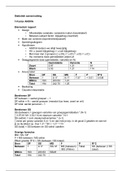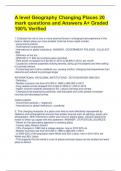E- commerce
Week 1
Intermediation= Someone in the value chain who is in the company, so you have to go to the store to
for example book your vacation.
Disintermediation= The disappearance of an intermediate, so you can book your vacation directly
online.
Reintermediation= (booking.com) The reappearance of intermediaries, but in a different shape. Like
Spotify and booking.com. They do the work (searching) for you.
Mass individualization= Everyone feels special, and they think they are to the company, but for the
company they are just numbers.
Five ways to make money online (earning models):
- Trade model, direct product sales of products or services.
- Subscription model, generate money through sub
- Action model, facilitating services for others and take a percentage of the price for which the
product is sold.
- Advertising model, a company pays a third party to get on a website and this company will
generate money with every 1000 views
- Freemium model, minimalistic version of a product, you get access to the product, but you
have advertisements in between. Such as Spotify basic.
Single channel= Only a store available to buy products
Multi-channel= Stores, Internet and apps available
Cross-channel= Same as multi-channel, but you have to create an personal account, all the channels
are integrated.
Omnichannel= It is a cross-channel orientated strategy that organisations use to improve their users
experience. Omnichannel implies integration and orchestration of channels such that the experience
of engaging across all the channels someone chooses to use is as, or even more, efficient or pleasant
than using single channels in isolation.
,The customer journey=
Awareness-consideration-purchase-service-loyalty
The dots above are online, the dots on the downside are psychical. Potential moments when a
company can communicate to potential customers (touch points).
Customer journey description= A description of modern multichannel behaviour as consumers use
(1) different media to (2) select suppliers, make (3) purchases and gain customer support.
Customer decision journey=
Consumer driven, friends and family
Company driven, via advertising
What is an algorithm= Designed step by step procedure to preform an operation and which will lead
to the sought result if followed correctly. An algorithm produces the same output information given
the same input information, and several short algorithms can be combined to perform complex tasks
such as writing a computer program. EG are cookbook recipe, diagnosis and solving routine.
A third party buys a slot on a site, which will re-direct you to the site of the advertisement of the
company. ALGORITHM= All existing software
Week 2
Search engine marketing= a form of internet marketing that involves promotion of websites by
increasing their visibility in search engine results through optimisation and marketing.
Search engine optimization (SEO)= the process
of affecting the visibility of a website or a web
page in a search engine’s unpaid results- often
referred to as natural results.
Search engine advertising (SEA)= also called
search advertising and paid search marketing is
a method of placing online advertisement on
web pages that show results from search
engine queries.
,Free media to get traffic to your website= Email, social networks , pod casting, forums
Linkbuilding= Identifying and building relationships between different websites. Creating a hyperlink
between different websites. The more links you have, the higher your website will be on the internet
(SEO)
Affiliate marketing= a partnerships between websites/stores. (bike store with a link to the
helmetstore, UK)
Cookies are used for advertisement. They use a tracking devise so they know perfectly which sites
you have visited.
Social media= are computer-mediated technologies that facilitate the creation and sharing
of information, ideas, career interests and other forms of expression via virtual
communities and social networking services.
Viral marketing=
Goal: brand awareness
How?
• Create material which is (potential) viral: attractive/emotional content
• Seed the material across the social platforms
• Track the results
The response (retweets, likes, views, positive/negative)
The results (number of visits, transactions, etc.)
Science of persuasion=
1, reciprocity; I do something for you, I want something back. Customer signs up for a newsletter,
and he will receive a discount.
2, scarcity; There are only a few products left.
3, authority; If an institution says the product is good, you are more willing to buy the product.
4, consistency; To keep them coming back, sends an email (thank you for your buy, I hope to see you
again)
5, liking; A lot of people like the product (positive review), so you will buy it sooner.
6, consensus/social proof; Reminder that you still have something in your shopping bag for example.
Everybody is doing it, so you should do it as well.
Customer life cycle= a term used to describe the progression of steps a customer goes through when
considering, purchasing, using and maintaining loyalty to a product or service.
, Example of a customer life cycle.
Difference between customer life cycle and
customers journey= customer life cycle is
from a customers point of view, and the
customers journey is from the companies
point of view.
Marketing objectives are decided by the
following model: SARE!!!
KPI= Key performance indicators.
Reach= How many people clicked on
the link from your website.
ACT= How many people actually stayed
on the site. Bounce rate= people that
stay on the website for a few seconds.
Convert= You convert them from
visitor to customer.
Engage= What is interesting about
your customers. Can you start a loyalty
program etc?....
Week 1
Intermediation= Someone in the value chain who is in the company, so you have to go to the store to
for example book your vacation.
Disintermediation= The disappearance of an intermediate, so you can book your vacation directly
online.
Reintermediation= (booking.com) The reappearance of intermediaries, but in a different shape. Like
Spotify and booking.com. They do the work (searching) for you.
Mass individualization= Everyone feels special, and they think they are to the company, but for the
company they are just numbers.
Five ways to make money online (earning models):
- Trade model, direct product sales of products or services.
- Subscription model, generate money through sub
- Action model, facilitating services for others and take a percentage of the price for which the
product is sold.
- Advertising model, a company pays a third party to get on a website and this company will
generate money with every 1000 views
- Freemium model, minimalistic version of a product, you get access to the product, but you
have advertisements in between. Such as Spotify basic.
Single channel= Only a store available to buy products
Multi-channel= Stores, Internet and apps available
Cross-channel= Same as multi-channel, but you have to create an personal account, all the channels
are integrated.
Omnichannel= It is a cross-channel orientated strategy that organisations use to improve their users
experience. Omnichannel implies integration and orchestration of channels such that the experience
of engaging across all the channels someone chooses to use is as, or even more, efficient or pleasant
than using single channels in isolation.
,The customer journey=
Awareness-consideration-purchase-service-loyalty
The dots above are online, the dots on the downside are psychical. Potential moments when a
company can communicate to potential customers (touch points).
Customer journey description= A description of modern multichannel behaviour as consumers use
(1) different media to (2) select suppliers, make (3) purchases and gain customer support.
Customer decision journey=
Consumer driven, friends and family
Company driven, via advertising
What is an algorithm= Designed step by step procedure to preform an operation and which will lead
to the sought result if followed correctly. An algorithm produces the same output information given
the same input information, and several short algorithms can be combined to perform complex tasks
such as writing a computer program. EG are cookbook recipe, diagnosis and solving routine.
A third party buys a slot on a site, which will re-direct you to the site of the advertisement of the
company. ALGORITHM= All existing software
Week 2
Search engine marketing= a form of internet marketing that involves promotion of websites by
increasing their visibility in search engine results through optimisation and marketing.
Search engine optimization (SEO)= the process
of affecting the visibility of a website or a web
page in a search engine’s unpaid results- often
referred to as natural results.
Search engine advertising (SEA)= also called
search advertising and paid search marketing is
a method of placing online advertisement on
web pages that show results from search
engine queries.
,Free media to get traffic to your website= Email, social networks , pod casting, forums
Linkbuilding= Identifying and building relationships between different websites. Creating a hyperlink
between different websites. The more links you have, the higher your website will be on the internet
(SEO)
Affiliate marketing= a partnerships between websites/stores. (bike store with a link to the
helmetstore, UK)
Cookies are used for advertisement. They use a tracking devise so they know perfectly which sites
you have visited.
Social media= are computer-mediated technologies that facilitate the creation and sharing
of information, ideas, career interests and other forms of expression via virtual
communities and social networking services.
Viral marketing=
Goal: brand awareness
How?
• Create material which is (potential) viral: attractive/emotional content
• Seed the material across the social platforms
• Track the results
The response (retweets, likes, views, positive/negative)
The results (number of visits, transactions, etc.)
Science of persuasion=
1, reciprocity; I do something for you, I want something back. Customer signs up for a newsletter,
and he will receive a discount.
2, scarcity; There are only a few products left.
3, authority; If an institution says the product is good, you are more willing to buy the product.
4, consistency; To keep them coming back, sends an email (thank you for your buy, I hope to see you
again)
5, liking; A lot of people like the product (positive review), so you will buy it sooner.
6, consensus/social proof; Reminder that you still have something in your shopping bag for example.
Everybody is doing it, so you should do it as well.
Customer life cycle= a term used to describe the progression of steps a customer goes through when
considering, purchasing, using and maintaining loyalty to a product or service.
, Example of a customer life cycle.
Difference between customer life cycle and
customers journey= customer life cycle is
from a customers point of view, and the
customers journey is from the companies
point of view.
Marketing objectives are decided by the
following model: SARE!!!
KPI= Key performance indicators.
Reach= How many people clicked on
the link from your website.
ACT= How many people actually stayed
on the site. Bounce rate= people that
stay on the website for a few seconds.
Convert= You convert them from
visitor to customer.
Engage= What is interesting about
your customers. Can you start a loyalty
program etc?....



